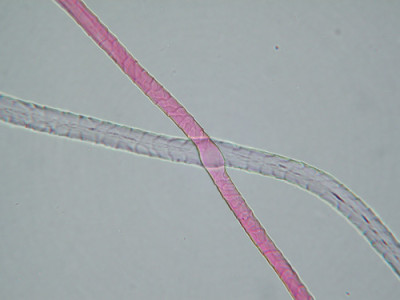Fibers (Natural)
While an infrared spectrometer can identify a fiber as cellulose or protein, it takes additional skill and experience to determine if the cellulose originates from wood, cotton, rayon, or another type of vegetable fiber. Similarly, proteinaceous fibers could be nylon, silk, or wool. A casual microscopist may be able to provide some basic characterization; however, it takes a good deal of knowledge and a reference collection with strong provenance to identify and scientifically support identifications of these types of materials.
The following describes some of our areas of expertise in natural fiber analysis. You can also learn more about our capabilities for synthetic fiber and non-textile animal hairs characterization capabilities by visiting those pages.
Vegetable Fibers
Vegetable fiber identification focuses largely on the identification of commercial vegetable fibers, which include, among others, manila hemp (Abaca), cotton, flax (Linum usitatissimum), hemp (Cannabis sativa), jute (Corchorus capsularis), ramie (Boehmeria nivea), and sisal (Agave sisalana). These identifications are based largely on morphological study and a solid understanding of plant anatomy. For this reason, Microtrace has built up and curates a large collection of reference vegetable fibers and has studied with world renowned experts in the science of vegetable fiber identification. We now teach one of the few vegetable fiber identification classes offered in the world.
Fiber Treatments
Treatments to fibers such as optical brighteners, dyes, and colorants can all be studied and compared, when appropriate.
Animal Fibers
Similar to vegetable fibers, animal textile fiber identification is based largely upon morphology. Wool, silk, mohair, cashmere, and camel may all be encountered. A wide variety of other animal hair types may be encountered in commerce, often when used as furs or decorative trims. Identification of such materials can be used to support or refute customs inquiries. Further detail on animal hair examinations can be found here.
Wood Fibers
Wood fibers are largely used in paper and wood products and are subject to their own sets of treatments and processing. In addition to identifying the broad type of wood (coniferous vs. deciduous), it is often possible to take the identification to genus or, in some cases, species. Many of the treatment processes such as the type of pulping (sulfite, mechanical, kraft, etc.) can be ascertained, as can other types of information about the ultimate product. See pages on wood identification and paper analysis for more details.
Related standardized methods: ASTM D123, D276, D629, D1776, D2118, D2130, D2817, D3822, D4491, E2224, E2225, E2227, E2228
How May We Help You?
Contact usto discuss your project in more detail.








